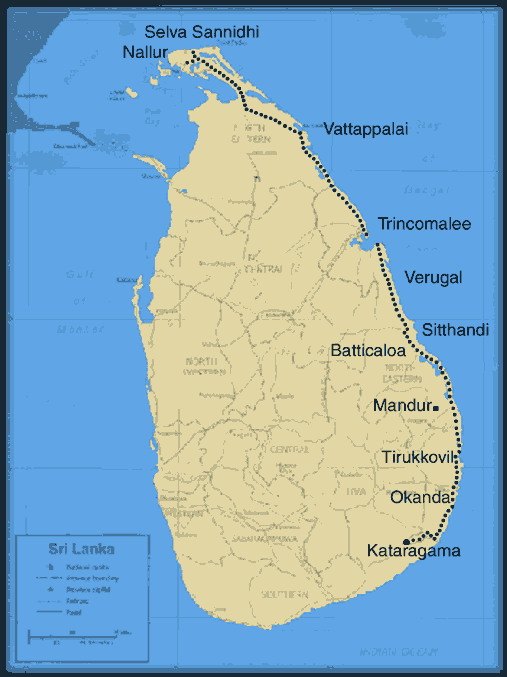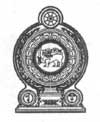
|
||||||||||||||||
|
| ||||||||||||||||
 Renewing the ties of a multi-cultural society
Speech of Hon. Minister of Foreign Affairs Mr. Tyronne Fernando M.P., P.C., at the Pada Yatra Media launch on 22nd April 2002 at the Sri Lanka Institute of International Relations, ColomboYour Excellencies, Ladies and Gentleman, I am very glad to be here today to facilitate the launch of the traditional Pada Yatra foot pilgrimage from Jaffna, that has been conducted by the faithful over centuries. Since the restoration of the Pada Yatra tradition in 1988 by the Kataragama Devotees Trust and Cultural Survival after a five-year break caused by conflict, the Yatra has commenced from Trincomalee. With the restoration of peace this year, Pada Yatra pilgrims will again begin in Jaffna and walk from shrine to shrine on their way to Kataragama, teaching through myth and metaphor the oral traditions of Sri Lanka. A Sri Lanka they called blessed – and we call Dhammadweepa. One of the blessings of peace is that pilgrimage can once more become the glue that binds us as a multi-cultural society. Buddhists can now go to Nagadipa and Seruvila; Hindus to Kataragama: and Catholics to Madhu. Indian pilgrims can once more fulfil ritual obligations and continue their pilgrimage of sacred sites from Kailasa to Kataragama. To Hindus the High God Shiva abides in the Himalayas on Mount Kailasa while his son Murugan resides in Kataragama also called Dakshina Kailasa or Southern Kailasa. Kailasa and Kataragama represent the north and southern extremities of the identical axis. The Kataragama region is also called Deviyange Kaele or the God's Forest by the Sinhalese and the Khizer region by the Muslims who believe it to be the abode of the Green Sufi – teacher even of the Prophet Moses. South Indian Shaivites believe that the youthful Himalayan god Murugan made five stops on his descent down into the plains in South India. His final resting place is however Kataragama. He was attracted here by a Vedda girl called Valli – said to be the green goddess of the forest. This myth has endured centuries and still attracts devotees in hundreds of thousands throughout Sri Lanka and South India. The Pada Yatra Communications Campaign seeks to reposition Sri Lanka and present her in the light of her ancient glory to attract once again to her shores the Arya Sangha from the four quarters of the world. Sri Lanka has caves bearing rock inscriptions stating that they have been donated for that very purpose from mythical times. This campaign has already achieved a great deal in promoting this perspective internationally.
The Living Heritage portal of websites is growing every day. The very comprehensive Kataragama site with 150 pages attracted Discovery Channel to our shores two years ago. Under Article 8 (J) of the Convention on Biological Diversity, to which we are signatories, we are bound to preserve and protect people living traditional lifestyles. The Pada Yatra is a symbol of our living heritage, and moreover is a traditional teaching instrument, where the elder pilgrims become the storytellers. This motif is present in every tradition. The wayside shelter is the ambalama, and the pilgrim our pina from the ditti Ambalamey Pina, Pina. Using tradition and culture as symbols of unification is the polarizing strength of this campaign, which I commend to you. I have known and worked with some of the people involved with Cultural Survival quite closely. In 1992 I delivered the annual Ananda Coomaraswamy Oration under their patronage. In fact in my Independence Day message I quoted Coomaraswamy. A quote that I would like to repeat to you today. It is from the Ten Essays on the Dance of Shiva published in 1923. "Each race contributes something essential to the world's civilization in the course of its own self-expression and self-realization. The character built up in solving its own problems, in the experience of its own misfortunes is itself a gift which each offers to the world. The essential contribution of India, then, is simply her India-ness; her great humiliation would be to substitute or to have substituted for this own character (sva-bhava) a cosmopolitan veneer, for then indeed she must come before the world empty-handed." What applies to India applies to Sri Lanka as well. Today a network of Living Heritage websites brings to the world an alternative Sri Lanka. It is this Sri Lanka that the sponsors of this initiative invite others to understand and visit. In their several websites PadaYatra.org; Kataragama.org; Murugan.org; DaladaMaligawa.org; Sigiriya.org; SriPada.org; CulturalSurvivalTrust.org their imagery is that of a land of the blessed. Cultural Survival re-created a rural wewa based environment at a village called Ulpotha, which I visited a few years ago. They gave the area and the people in the neighborhood a better value for their setting, knowledge and skills in exchange for visitors seeking an experience of village life. Sustaining traditional lifestyles through niche marketing of village goods and services at fair value is another of their achievements. Currently they are developing a much larger Heritage Reserve in Koslanda, where Living Heritage becomes the product. Today's communications launch centres round this year's Pada Yatra. The Yatra has happened without any fanfare in the media over the last eleven years and in spite of this, last year there were 10,000 pilgrims. This year with peace many more are expected. While we must encourage and facilitate the Yatra and use it to show the world the quality of our traditional wisdom and ‘common sense' we must help eradicate from the Yatra what crowds sometimes brings in their wake. Unruly behavior, noise, garbage and pollution. The old way ceases and new way takes over, and the Pada Yatra loses its sacred nature. The Yatra moves across large areas of unspoiled land. The Yala East National Park due to visitor traffic being minimal for the last several years is an unspoiled oasis. The Yatra crosses the park over a two week period, and last year I am told that unauthorized structures and vehicles, the lack of water and toilets made the Park crossing an ordeal for the pilgrims. Unlike other cultural properties the Yatra has no structural organization. Everyone is a volunteer. The organizers who are also unpaid volunteers, with their experience of over thirteen years of being the patrons of the Yatra, has taught them how best we can help facilitate the Pada Yatra this year. All of you can help us in some way. All the factors to make this a multimedia twenty-first century media event are in place. The Dhamma discussions that take place on the way can be made into short programmes. These programmes can be shown on streaming video on the Internet as well as on local television and in South India. The media is today full of events. The Foreign Ministry gave fifty-six foreign journalist's accreditation to attend Mr. Prabhakaran's recent press conference. Can we persuade the media to show the same zest for the Arya Sangha who call peace their culture? Is there a story here? Will the LTTE join hands with us in preserving the sacred nature of the pilgrimage and prevent the pollution of the environment?Can this be a media event based on good news – of cooperation for mutual benefit? The Pada Yatra is an event like Chaucer's Canterbury Tales. We have a cast of thousands of colorful characters. Everyone is different but they all follow the same road south. The sponsors of this campaign want the Pada Yatra experience given the largest and widest possible coverage to show the world that our living heritage is second to none. We have the knowledge and the information and the technology but do we know how to use it? That is the challenge before us. It is the Foreign Ministry that projects the window into Sri Lanka for the world. The Ranil Wickremasinghe Government has decided to re-position Sri Lanka and give her back the qualitative image that she has been associated with for centuries. My Ministry is working on this right now. This campaign of peace and reconciliation is one small part of a larger whole in which all of us can play our different roles. I recommend to all of you that you listen to the organizers present their case and if you feel that you can be of assistance to maximize the impact of this very positive and time-honored message of peace, to kindly join in the campaign and be a part of the team that projects Sri Lanka as she rightly deserves – a land of infinite possibilities. I now invite Manik Sandrasagra of Cultural Survival to introduce the concept of this campaign to you. The Hon. Minister's speech was published in The Sunday Times of 30 April, 2002. Organized by the Kataragama Devotees Trust, Cultural Survival and the Living Heritage Network and facilitated by:
| ||||||||||||||||



